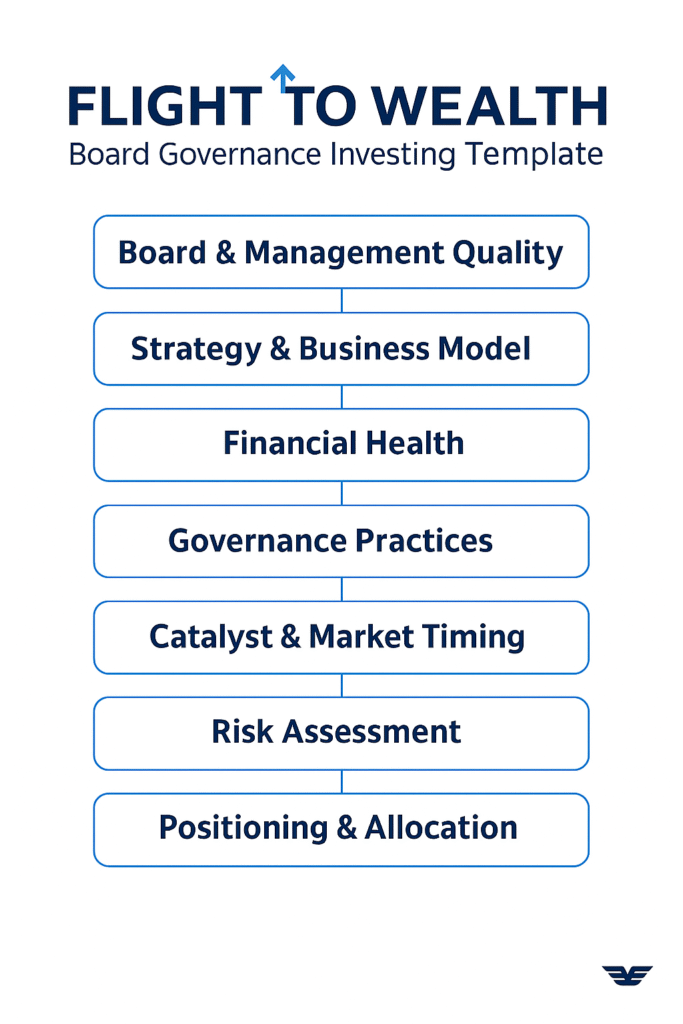When investing, most people focus on earnings, revenue growth, or what analysts say. But what if the secret
to smarter investing lies in something less obvious—the quality of a company’s board and management? After tuning
into the Boardroom Governance with Evan Epstein podcast featuring Jonathan Foster, I was inspired to rethink
how I evaluate companies. The people steering the ship, especially at the board level, have a profound impact on a
company’s long-term success and risk profile.
Why Board Quality Matters
A high-quality board is much more than a rubber stamp for company reports—they shape strategy, oversee risks, and hold
management accountable. Boards with experienced, independent directors aligned with shareholder interests tend to
make wise capital allocation decisions, avoid hype cycles, and build sustainable growth over time. For example,
Apple’s board in the 2000s played a crucial role in supporting innovation while maintaining financial discipline,
fueling decades of growth. On the flip side, boards overly dominated by founders or lacking independence sometimes fail
to prevent risky decisions that can erode shareholder value.
How to Identify Board Quality
To evaluate board quality, look closely at each member’s background, including:
- Industry experience and successful track record
- Independence from management to prevent conflicts of interest
- Alignment through stock ownership or incentives
- Historical capital allocation decisions around mergers, R&D, and dividends
Tools like company websites, proxy statements, and independent profiles provide insight into directors’ credentials
and how they serve collectively.
Applying the Board Governance Lens to Investing
I combine this focus on board quality with my Moonshot Scorecard, which scores companies across:
- Board & Management Quality: Evaluates the experience, independence, and alignment of the leadership team. Quick check: Look at the company’s leadership page, LinkedIn profiles, tenure, and track record of past successes.
- Strategy & Business Model: Understand what problem the company solves and how it makes money. Quick check: Review investor presentations, annual report summaries, and recent news for clarity of mission and market fit.
- Financial Health: Measures cash position, debt, and profitability. Quick check: Use Yahoo Finance or Google Finance to see cash, debt-to-equity, margins, and recent earnings trends.
- Governance Practices: Assesses the checks and balances in the company. Quick check: Check the governance section on the website or proxy statements for audit committees, shareholder rights, and executive compensation alignment.
- Catalyst & Market Timing: Identifies upcoming events that could affect stock value. Quick check: Look for press releases, product launches, regulatory approvals, or milestones expected within 1–3 years.
- Risk Assessment: Evaluates exposure to cyclical trends, regulation, and competitors. Quick check: Read news articles, analyst summaries, and sector trends to spot major risks quickly.
- Positioning & Allocation: Determines how this stock fits within your portfolio. Quick check: Compare price to historical ranges, other holdings, and potential diversification benefits or concentration risks.
This comprehensive lens helps uncover investment opportunities beyond analyst opinions, emphasizing leadership
and strategic decision-making.
Case Study 1: Lear Corporation (LEA)
LEA is a global automotive supplier specializing in seating and electrical systems, with strong exposure to EV growth.
Governance & Moonshot Scorecard
| Category | Score (1–5) | Rationale / Notes |
|---|---|---|
| Board & Management Quality | 4 | Experienced leadership, aligned incentives, strong OEM relationships. |
| Strategy & Business Model | 4 | Core supplier; EV systems provide growth and diversified revenue streams. |
| Financial Health | 5 | Profitable, low debt, strong margins, sustainable dividend and cash flow. |
| Governance Practices | 4 | Solid audit and risk oversight, transparent reporting and controls. |
| Catalyst & Market Timing | 3 | Near-term catalysts include EV adoption and cyclical automotive recovery. |
| Risk Assessment | 3 | Exposure to automotive cyclicality, commodity, and interest rate risks. |
| Positioning & Allocation | 4 | Fits core cyclical/EV growth allocation. |
Total Score: 27/35 → Strong core moonshot candidate
Recommended allocation: 6%–8% of portfolio
Case Study 2: Five Point Holdings (FPH)
FPH is a California-based real estate developer. Its board is competent but less differentiated, with higher cyclical and regulatory exposure.
Governance & Moonshot Scorecard
| Category | Score (1–5) | Rationale / Notes |
|---|---|---|
| Board & Management Quality | 3 | Competent board, less differentiated; experience mostly in local real estate. |
| Strategy & Business Model | 3 | Focused on California real estate development; cyclical sector with concentrated market exposure. |
| Financial Health | 3 | Moderate cash position, project-dependent revenues; low debt but cyclical exposure. |
| Governance Practices | 3 | Adequate controls, no major red flags; less strategic differentiation than LEA. |
| Catalyst & Market Timing | 2 | Dependent on land sales milestones; no immediate disruptive catalysts. |
| Risk Assessment | 2 | High regulatory exposure in California; cyclical and interest rate risks. |
| Positioning & Allocation | 3 | Small speculative allocation recommended for growth/cyclical exposure. |
Total Score: 19/35 → Watchlist / Small speculative position
Recommended allocation: 2%–4% of portfolio
| Stock | Total Score (Moonshot) | Interpretation | Suggested Portfolio Allocation | Notes / Risks |
|---|---|---|---|---|
| LEA (Lear Corporation) | 27 / 35 | Strong core moonshot candidate | 6%–8% | Experienced board, EV growth exposure, automotive cyclicality, commodity/interest rate risk |
| FPH (Five Point Holdings) | 19 / 35 | Watchlist / small speculative position | 2%–4% | Competent but less differentiated board, real estate cyclical & regulatory exposure |
Why This Perspective Matters
Thinking like a board member transforms investing from reactive speculation into strategic evaluation. It asks:
- Are the incentives aligned for long-term value creation?
- Does the company have credible strategy and risk oversight?
- Are catalysts in the near term likely to impact performance materially?
Combining board governance insights with traditional financial metrics helps build portfolios with deeper strategic
insights and better risk awareness.
Board governance is a powerful, often overlooked lens for investors. By paying attention to leadership quality, decision-making,
and accountability, investors can find opportunities with stronger foundations for sustainable growth.
Explore this approach alongside your own Moonshot Scorecard for a more strategic investment journey.
For more insights on board governance, check out the
Boardroom Governance Podcast
.

